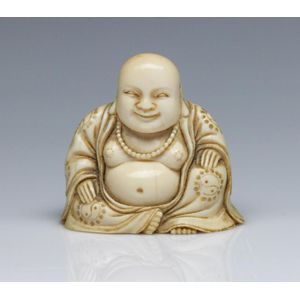Seated Hotei Ivory Figure with Yin Yang Robe
You must be a subscriber, and be logged in to view price and dealer details.
Subscribe Now to view actual auction price for this item
When you subscribe, you have the option of setting the currency in which to display prices to $Au, $US, $NZ or Stg.
- Ivory - Ivory is a hard white material that comes from the tusks of elephants, mammoth, walrus and boar, or from the teeth of hippopotamus and whales. The ivory from the African elephant is the most prized source of ivory. Although the mammoth is extinct, tusks are still being unearthed in Russia and offered for sale.
Ivory has been used since the earliest times as a material for sculpture of small items, both in Europe and the east, principally China and Japan.
In Asia ivory has been carved for netsuke, seals, okimono, card cases, fan supports, animals and other figures and even as carved tusks.
In the last 200 years in Europe ivory has been used to carve figures, for elaborate tankards, snuff boxes, cane handles, embroidery and sewing accessories, in jewellery and as inlay on furniture. Its more practical uses include being used for billiard balls, buttons, and a veneers on the top of piano keys.
The use and trade of elephant ivory have become controversial because they have contributed to Due to the decline in elephant populations because of the trade in ivory, the Asian elephant was placed on Appendix One of the Convention on International Trade in Endangered Species (CITES), in 1975, and in January 1990, the African elephant was similarly listed. Under Appendix One, international trade in Asian or African elephant ivory between member countries is forbidden. Unlike trade in elephant tusks, trade in mammoth tusks is legal.
Since the invention of plastics, there have been many attempts to create an artificial ivory
This item has been included into following indexes:
Visually similar items

A small Galle cameo vase, circa 1904-1914 of straight sided tapering form with a single layer light green thistle acid etched design over an ecru frosted ground, bearing the posthumous starred signature of Galle in relief to the body. Height 10 cm

An old Japanese katana sword, visible temper line to blade, the tang with engraved character marks, military leather stitched scabbard. Blade length 54.5 cm

A carved ivory tusk, Qing Dynasty, 19th century in the form of a gently curved pine trunk raft carrying numerous figures variously occupied, some seated at tables drinking, listening to others playing musical instruments, and maidens seated at the prow pad

Antique French 18ct gold and nugget pearl necklace three strand white nugget pear collar with a 18ct gold two hand form clasp set with decorative gem stones marked twice with French mark 18ct 1838-19. 44 cm length
